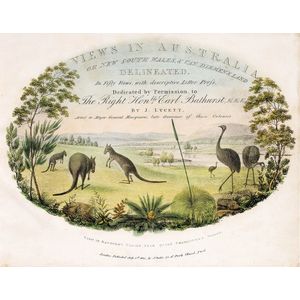Views in Australia: Lycett's Hand-Coloured Aquatints
You must be a subscriber, and be logged in to view price and dealer details.
Subscribe Now to view actual auction price for this item
When you subscribe, you have the option of setting the currency in which to display prices to $Au, $US, $NZ or Stg.
- Aquatint - The arabesque pattern is an ornamental design that features flowing, curving lines and elaborate geometric shapes. It is inspired by the art and architecture of the Islamic world and was developed at Fontainebleu France in the mid 16th century. Its use was spread through published engravings, and it is characterized by its intricate and highly decorative nature. The arabesque pattern is created using a repetitive motif that is repeated and interwoven to create a cohesive design. It was used as a form of decoration in art, architecture, textiles, pottery, furniture and ceramics and it is often used to add a sense of grandeur and sophistication to a design. The arabesque pattern is admired for its beauty and complexity, and it continues to be used in a wide range of decorative contexts today.
- Marbling - A descriptive term for a finish applied to plastic, ceramics, glass, plaster or wood to imitate the colours and characteristic markings of various marble types. For moulded items such as the first three above, the marbling is within the item.
Interiors and furniture were marbled from from the early 17th century to the late Victorian period. The craft was practiced by skilled decorators using a combination of brushes and sponges. Some of the finishes achieved were so realistic as to make it difficult to distinguish the marbled surface from the marble surface.
Marbling is also a term applied to a finish for paper as often seen in the front and endpapers of old books. The marbling is achieved by floating the colours on water and then transferring them to paper. However the marbling finish on paper, as with the marbling finish on plastics, with its multitude of colours has little resemblance to naturally occurring marble. - Circa - A Latin term meaning 'about', often used in the antique trade to give an approximate date for the piece, usually considered to be five years on either side of the circa year. Thus, circa 1900 means the piece was made about 1900, probably between 1895 and 1905. The expression is sometimes abbreviated to c.1900.
This item has been included into following indexes:
Visually similar items

Two fine chains and a lapis lazuli set gold brooch, comprising a fine 9ct yellow gold figaro link chain in classic finish, a fine 9ct white gold chain suspending a fine cross pendant and a 9ct yellow gold framed round brooch set with a polished piece of la

A Portuguese Manuel Mafra Palissy majolica snake and reptile dish, 19th century, impressed factory marks. 21 cm diameter

Rare Spode Caramanian black print soup plate, City of Corinth' - variation, 25 cm diameter Printed Spode mark, early 19th century.

Spode Caramanian plate, Necropolis', impressed Spode mark to base, 21 cm diameter approx.
